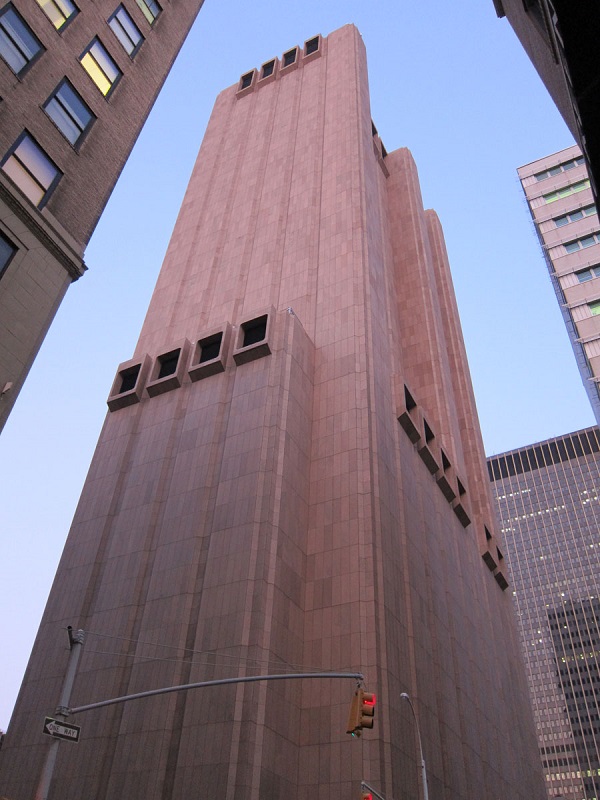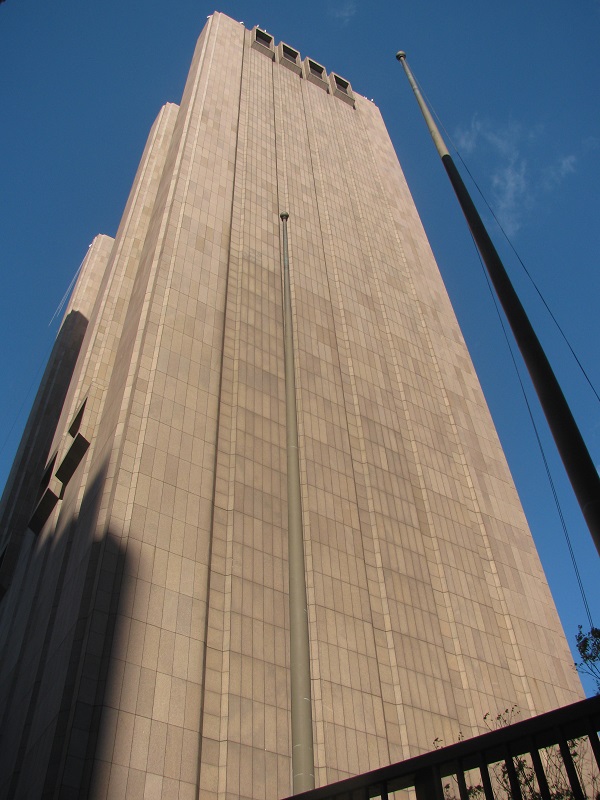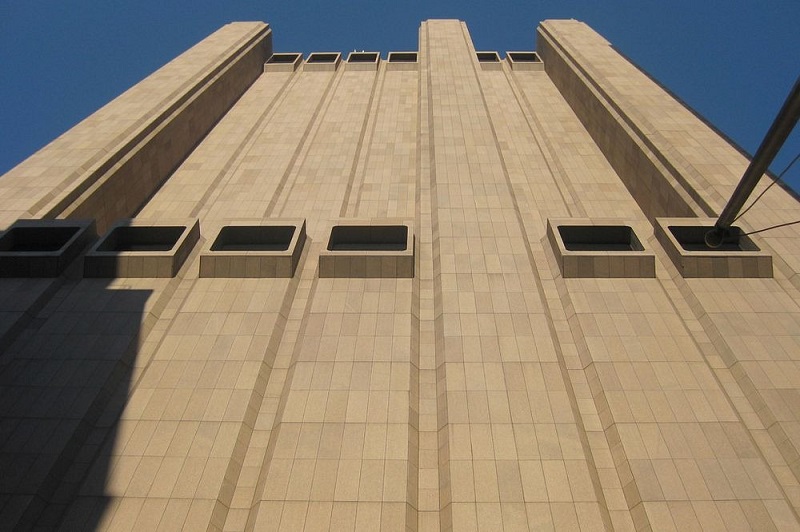33 Thomas Street, New York
Contents |
[edit] Introduction
33 Thomas Street, also known as the ‘Long Lines Building’, is a heavily-fortified Brutalist skyscraper located in Lower Manhattan, New York. It was constructed between 1969 and 1974 to serve as a major telecommunications hub for the New York Telephone Company, a subsidiary of AT&T.
It has been a site of mystery to New Yorkers for many years because of the scant information available about its purpose or operations. All that was really known was that it was one of the most secure buildings in America, designed to be self-sufficient and protected from nuclear fallout for up to a fortnight following an attack.
In November 2016, The Intercept published an exclusive report, based on documents leaked by whistleblower Edward Snowden, which provided compelling evidence that the National Security Agency (NSA) has been using the skyscraper as a covert surveillance and electronic spying centre.
[edit] Design and construction
The ‘Long Lines Building’ was designed by the architectural practice John Carl Warnecke & Associates. Some of the original architectural drawings, seen by The Intercept, are labelled ‘Project X’. Warnecke’s brief was to design a ‘20th century fortress’, secure enough to withstand an atomic blast and fallout - a ‘skyscraper inhabited by machines’.
The 167.5 m (550 ft) tower is most unusual, even at first glance, as it has no windows, instead having exterior walls of precast concrete panels clad with pink-coloured granite. As per the original plans, the building is not illuminated, meaning that at night it becomes an enormous shadow in the sky.
From the rectangular base there are six large protusions housing air ducts, stairs and lifts. At the 10th and 29th floors there are a series of large ventilation openings. There are three below-ground levels, including a cable vault.
Another distinguishing design feature is the building’s high ceilings, with an average floor height of 5.5 m (18 ft). The floors are designed to bear unusually large live loads, 10-15 kPa or 200-300 pounds per sq. ft.
While it is unclear how many people work in the building, the original designs suggested 1,500 people would be provided with food, water and leisure facilities. To enable it to be self-sufficient in an emergency, 250,000 gallons of fuel are stored to power generators.
Since it was constructed, the building has been a curiosity to architecture fans, with its dystopian aesthetic contrasting so starkly with the more iconic structures of Manhattan. In 1982, the New York Times described it as being ‘one of the neighbourhood’s few pieces of good modern architecture… It blends into its surroundings more gracefully than does any other skyscraper in this area.”
[edit] Surveillance
Numerous documents leaked by the whistleblower Edward Snowden in 2013 referred to a ‘core surveillance site’ known as TITANPOINTE, although its exact location was unclear.
According to a November 2016 investigation by The Intercept, 33 Thomas Street is TITANPOINTE, and has been used to tap into millions of phone calls, faxes, and emails each day.
Allegedly, a secure room – the ‘Sensitive Compartmented Information Facility’ – records calls and internet data from around the world, and has been used to target the communications of the United Nations, the International Monetary Fund, the World Bank, and at least 38 countries including Germany, Japan and France.
The Intercept were able to link TITANPOINTE to 33 Thomas Street by analysing secret travel guides. One guide revealed that TITANPOINTE is in New York City, while another revealed that a ‘partner’ called LITHIUM oversees building visits at the facility (‘LITHIUM’ is apparently the NSA’s code name for AT&T).
The NSA have apparently declined to comment on the story.
[edit] Find out more
[edit] Related articles on Designing Buildings Wiki
- Brutalism.
- Building of the week series.
- Commercial security systems.
- Concrete.
- Constructivist architecture.
- Embedded security: Procuring an effective facility protective security system.
- High-tech architecture.
- Megastructure.
- Seagram Building.
- Security and the built environment.
- SIS Building.
- Spyscape.
- The Pentagon.
- Trump Tower New York.
[edit] External resources
- The Intercept - The NSA's spy hub in New York: Hidden in plain sight
Featured articles and news
RTPI leader to become new CIOB Chief Executive Officer
Dr Victoria Hills MRTPI, FICE to take over after Caroline Gumble’s departure.
Social and affordable housing, a long term plan for delivery
The “Delivering a Decade of Renewal for Social and Affordable Housing” strategy sets out future path.
A change to adoptive architecture
Effects of global weather warming on architectural detailing, material choice and human interaction.
The proposed publicly owned and backed subsidiary of Homes England, to facilitate new homes.
How big is the problem and what can we do to mitigate the effects?
Overheating guidance and tools for building designers
A number of cool guides to help with the heat.
The UK's Modern Industrial Strategy: A 10 year plan
Previous consultation criticism, current key elements and general support with some persisting reservations.
Building Safety Regulator reforms
New roles, new staff and a new fast track service pave the way for a single construction regulator.
Architectural Technologist CPDs and Communications
CIAT CPD… and how you can do it!
Cooling centres and cool spaces
Managing extreme heat in cities by directing the public to places for heat stress relief and water sources.
Winter gardens: A brief history and warm variations
Extending the season with glass in different forms and terms.
Restoring Great Yarmouth's Winter Gardens
Transforming one of the least sustainable constructions imaginable.
Construction Skills Mission Board launch sector drive
Newly formed government and industry collaboration set strategy for recruiting an additional 100,000 construction workers a year.
New Architects Code comes into effect in September 2025
ARB Architects Code of Conduct and Practice available with ongoing consultation regarding guidance.
Welsh Skills Body (Medr) launches ambitious plan
The new skills body brings together funding and regulation of tertiary education and research for the devolved nation.
Paul Gandy FCIOB announced as next CIOB President
Former Tilbury Douglas CEO takes helm.
UK Infrastructure: A 10 Year Strategy. In brief with reactions
With the National Infrastructure and Service Transformation Authority (NISTA).

























